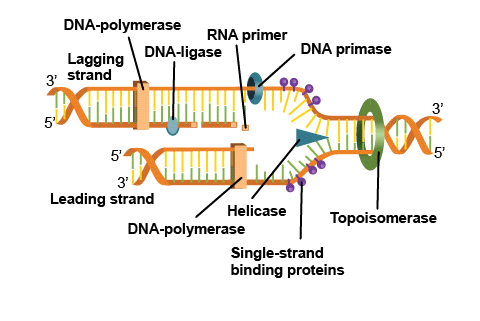Human Fbh1 helicase is important in the process of DNA replication. When a mutation occurs during the production of Fbh1, the result is a mutant Fbh1 that binds at the replication fork and prevents any helicase protein from attaching to the strand. Based on this information and the image shown, what would happen during DNA replication if this mutant helicase were present? A - Topoisomerase would unwind the DNA and an RNA primer would attach to the DNA molecule and initiate replication. The process would then stop at the blue triangle because helicase is needed to separate the strands of DNA. B - Topoisomerase would unwind the DNA, but then the process would stop at the blue triangle because helicase, the RNA primer, would not be able to attach to the DNA molecule and initiate replication. C - The process would begin at the blue triangle when topoisomerase unwinds the DNA and an RNA primer attaches to the DNA molecule and initiates replication. DNA polymerase would begin the synthesis of each side, but the process would stop because helicase would not be present to rejoin the replicated strands. D - The process could not begin at the blue triangle because helicase is needed to separate the strands of DNA and initiate the process.
Gene Interactions
When the expression of a single trait is influenced by two or more different non-allelic genes, it is termed as genetic interaction. According to Mendel's law of inheritance, each gene functions in its own way and does not depend on the function of another gene, i.e., a single gene controls each of seven characteristics considered, but the complex contribution of many different genes determine many traits of an organism.
Gene Expression
Gene expression is a process by which the instructions present in deoxyribonucleic acid (DNA) are converted into useful molecules such as proteins, and functional messenger ribonucleic (mRNA) molecules in the case of non-protein-coding genes.
Human Fbh1 helicase is important in the process of
Based on this information and the image shown, what would happen during DNA replication if this mutant helicase were present?
A - Topoisomerase would unwind the DNA and an RNA primer would attach to the DNA molecule and initiate replication. The process would then stop at the blue triangle because helicase is needed to separate the strands of DNA.
B - Topoisomerase would unwind the DNA, but then the process would stop at the blue triangle because helicase, the RNA primer, would not be able to attach to the DNA molecule and initiate replication.
C - The process would begin at the blue triangle when topoisomerase unwinds the DNA and an RNA primer attaches to the DNA molecule and initiates replication. DNA polymerase would begin the synthesis of each side, but the process would stop because helicase would not be present to rejoin the replicated strands.
D - The process could not begin at the blue triangle because helicase is needed to separate the strands of DNA and initiate the process.

Trending now
This is a popular solution!
Step by step
Solved in 2 steps


